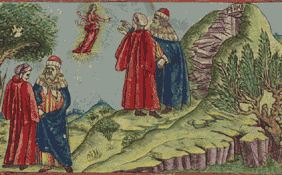|
|
The commentary tradition |

|
"What you have told me of my course, I write:
I keep it with another text, for comment
by one who'll understand, if I may reach her."
(Dante to Brunetto Latini, Inferno XV, 88–90, trans. Mandelbaum)
|
|
Inferno I, from the Florentine edition of 1481. LA(11)
|
|
|
From manuscripts to the printed editions of the present day, Dante's work has often been
accompanied by a commentary to explain the text to the reader. The first few printed
editions gave only the poem, but the Venice edition of 1477 came with the commentary of
Iacopo della Lana, as well as Boccaccio’s Vita and rubrics summarizing each canto.
For the rest of the century, almost all editions featured a commentary.
An edition with commentary cost considerably more than one without, and was for the
wealthier reader only. The size of editions also changed over time: all fifteen editions
printed during the fifteenth century are large "folios". In the sixteenth century,
however, most were printed in smaller, less expensive formats. The 1502 edition of the
celebrated printer Aldus Manutius was in the small "octavo" format and, for the first
time in over twenty years, went back to the plain text of Dante.
|

|
 |
| The heretics, Inferno X.
La commedia, with the commentary of Cristoforo Landino (Brescia: Boninus de Boninis,
de Ragusia, 1487). CUL SSS.4.15 [item not on display] |
|
Engraving for Inferno II, from
the Florentine edition of 1481. LA(11) [this image not on display]
|
.gif) |
| Aldine edition (1502). LA(19) |
|
|
|